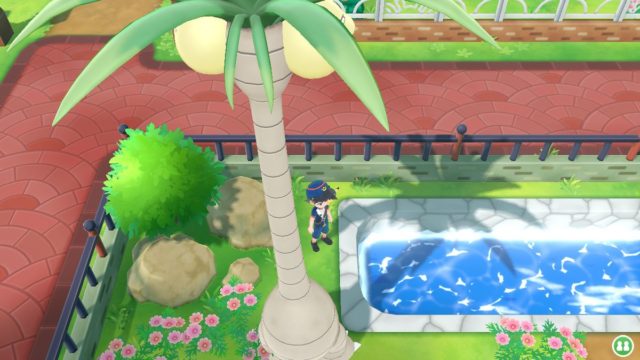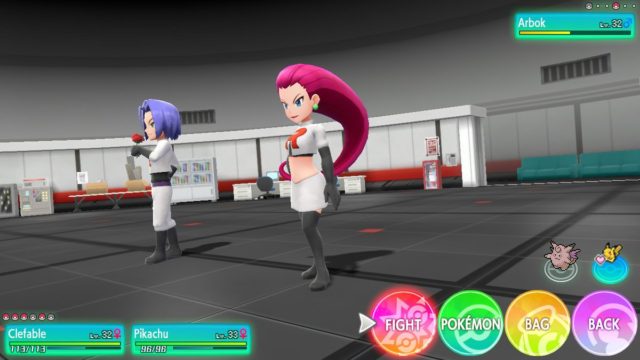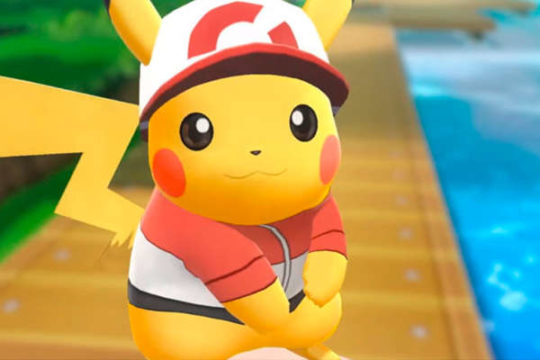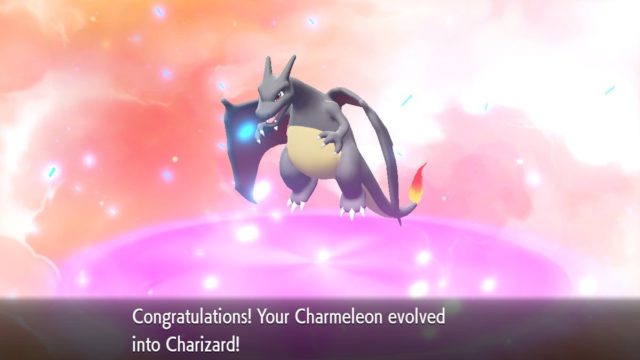Gorgeous presentation; Pokémon Go compatibility complements the game well; Poké Ball Plus is a delight to use
Single Joy-Con control scheme is a pain for single players; new catch system will turn off some longtime fans
A long time has passed since Pokémon Yellow arrived on Game Boy Color. While the title wasn’t a gigantic leap forward from Red and Blue, the game offered enough differences to convince many a Pokéfan to take a return trip to Kanto. Since then, the region has appeared a handful of times, both in the various incarnations of Gold and Silver and the FireRed and LeafGreen remakes. As such, it would be perfectly understandable if longtime Pokémon fans felt a bit of hesitation about visiting the region yet again. Fortunately, Pokémon: Let’s Go offers a compelling take on the original Pokémon world that should delight fans old and new.
From the outset, Pokémon: Let’s Go feels simultaneously familiar and quite different. The game’s core is a faithful reimagining of Pokémon Yellow: Jessie and James appear, the original starters can be acquired early on, and the plot is, essentially, the same. The way the world operates, however, has been tuned up for a new hardware generation. The pixelated Pokémon placeholders that once appeared throughout the game’s cities have now been replaced by gorgeous 3D models. While this certainly adds to the feel of a more authentic Pokémon world, Let’s Go takes things a step further with wild Pokémon that can be seen absolutely everywhere, from the grass, to the water and even in the skies as the shadows of Flying-types are cast on to the ground. There is such a liveliness to the world that has never been seen outside of the Pokémon anime, and Kanto feels so much richer as a result.

This, of course, leads to the game’s most controversial change: the process of catching Pokémon has been drastically altered. As Pokémon are now found in the field, encounters are no longer random (though tight areas can often make encounters unavoidable). Running into a wild Pokémon will trigger an encounter similar in spirit to Pokémon Go. For the most part, players no longer battle Pokémon before lobbing Poké Balls at them, instead increasing the likelihood of capture through well-timed throws. The process is different for Snorlax and the game’s legendary Pokémon, however. Players must battle and defeat those particular Pokémon in battle before they can start lobbing. That doesn’t mean it’s necessarily easier; Articuno depleted a huge number of Poké Balls before I finally captured it. Thankfully, Poké Balls are incredibly easy to come by, as you receive them after nearly every trainer battle in the game (of which there are many). All said, the new process takes some getting used to. It is, after all, a major departure from something that’s been in place since the first generation of games. I didn’t dislike the change (in fact, I loved seeing the Pokémon in the fields), but it was certainly unusual. It will be interesting to see if it changes back for future entries in the series.
The new catch system is accompanied by a handful of new control schemes. In handheld mode, the game controls exactly as one would expect a Pokémon game to, and players use a cursor in catch mode to increase their likelihood of capturing the Pokémon. In docked mode, things are significantly different. Players can either use one of the two Joy-Con controllers held in an upright position, or the Poké Ball Plus. Out of all the game’s control methods, the Joy-Con control setup is probably the most difficult to get accustomed to. While the option was included to make it easier for a second player to easily jump in, it’s just plain awkward in single player mode. It would have been nice if a single player dual Joy-Con option was included in the game.
While the Poké Ball Plus can be equally tough to get used to, it does have one significant advantage over the single Joy-Con control option: it’s really, really fun to use. The Poké Ball Plus is a rather neat piece of tech. In a lot of ways, it’s reminiscent of the Wii Remote: it will make you want to show it off to friends and family. There’s just something truly special about “tossing” a Poké Ball, feeling the creature wiggle inside, and then hearing its cry as the ball snaps shut. Like the aforementioned Wii Remote though, the Poké Ball Plus isn’t flawless. It can sometimes be hard to get accurate throws and extended play can make your hand start to cramp up. But it’s a small price to pay for an otherwise delightful addition to the game.

One of the most surprising things about Pokémon: Let’s Go is just how cinematic the game is. When the original Pokémon games released, the anime, manga and TCG helped flesh out some of the game’s major characters in a way that an 8-bit game just couldn’t manage. With each subsequent generation, Game Freak has been able to take things further, adding more emphasis on story and adding details they couldn’t in earlier games. Supposedly Ultra Sun and Ultra Moon were originally planned for Switch before the decision was made to release something “bigger” for the system’s first mainline Pokémon game. This was clearly the right decision as the developer has taken great advantage of the new hardware’s abilities. With Let’s Go, things have progressed to a new level: Pokémon gyms feel bigger and more bombastic (Cinnabar Island’s gym is a total blast), Jessie and James are as annoyingly lovable as ever and characters and plot points from sequels even appear to foreshadow their roles in future games. Pokémon Yellow was developed to build a bridge between the anime and games but, at times, Pokémon: Let’s Go legitimately feels like the world we could only previously see in the cartoon.
As in the cartoon, the player’s starting Pokémon will ride on their trainer’s shoulder. This, of course, is decided based on whether the player purchases the Pikachu or Eevee version of Pokémon: Let’s Go. Buyers will want to choose wisely, because the characters play a much bigger role in the game than previous starters. Players can teach the duo a variety of exclusive new moves, dress up their trainer and starter in matching outfits, or just play around in a mode reminiscent of X and Y’s Pokémon-Amie. As in Sun and Moon, HMs have been scrapped, this time in favor of “secret techniques” learned by your starter. No matter what they’re doing, Pikachu and Eevee are gorgeously animated with voicework that absolutely blows away anything seen in the franchise before.

The return to Kanto brings with it a focus on Pokémon that debuted in the region. For the most part, Let’s Go focuses exclusively on the original 151 Pokémon with Pikachu and Eevee naturally taking the lead. Sadly, the game does not include any evolutionary forms that came in subsequent generations, such as Scizor or Magnezone. Despite Eevee’s co-starring role, even the creature’s later evolutions (such as Umbreon and Glaceon) have been left on the cutting room floor. The game does include some notable exceptions to the rule, however. There is, of course, Meltan and its evolution Melmetal, both of which can only be acquired by completing tasks between Let’s Go and Go. The game also includes Mega Evolutions and Alolan forms, both of which debuted in the previous two generations. Finally, Pokémon that changed types over the years have retained those changes. For example, Magnemite debuted in Red and Green as an Electric-type Pokémon, but Gold and Silver updated the creature to an Electric and Steel-type. These additions may seem minor in the grand scheme of things, but making Dark, Steel and Fairy-type Pokémon relatively easy to come by in Kanto really helps to balance out the unfair advantage afforded to Pokémon like Dragonite and Mewtwo in the original games.
Let’s Go‘s compatibility with Pokémon Go was one inclusion that (understandably) drew some skepticism when it was initially announced. Fortunately, the link between the two games works well from a technological standpoint and also adds another layer of enjoyment to Let’s Go. While games like Pokémon Stadium have given players the ability to import their creatures into more advanced technology in the past, the ability to link with Go is significant in a rather unique way: it’s much easier to play both titles concurrently. With Stadium, there was an expectation that you had probably already finished playing at least one of the first generation Pokémon games. With Go and Let’s Go, there is a nice opportunity to play the games at the same time and have the two experiences complement one another. Before facing the Elite Four in Let’s Go, I had the luck of finding a Shiny Charmander in Go. I quickly transferred my new creature to the Switch game, immediately started training it and had a very cool Shiny Charizard to face Lorelei’s Jynx! Transfers from the mobile game to Switch are incredibly simple, and it really helps increase the value of Go in the long run. It’s not without some hiccups: diehard Go fans may not like the fact that Pokémon cannot be transferred back to the app. That said, I really hope Game Freak and Niantic continue working together because there is a lot more potential to build the relationship between the app and mainline games in the franchise moving forward.

Experienced Pokémon trainers should be able to speed through Pokémon: Let’s Go in about 25-30 hours, which tends to be the average for the series. Those looking to complete the Pokédex and challenge the title’s post-game content will, naturally, have to spend quite a bit more time with it. The post-game isn’t nearly as substantial as Ultra Sun and Ultra Moon or Gold and Silver, but there’s still a lot to do around Kanto after the defeat of the Elite Four. Each of the game’s Gym Leaders can be challenged again, with each boasting a significantly more powerful team. There are also 151 Master Trainers to defeat, with each one specializing in one specific Pokémon. Finally, there’s Melmetal; the new legendary Steel-type should take even the most talented Pokémon Go players at least a few weeks to acquire!
Pokémon: Let’s Go has certainly earned itself quite a bit of debate in the fan community. While fans clearly feel strongly about the changes made to the franchise formula, Game Freak has still managed to deliver a terrific Pokémon experience that lives up to the technological leap forward. Kanto feels more alive than ever before, and the original 151 Pokémon have never looked better. As a longtime fan of the franchise, I couldn’t help but find myself grinning from ear-to-ear. Whether you’re a longtimer like myself, a lapsed fan that came back with Pokémon Go or a newcomer, there’s something for everyone in Pokémon: Let’s Go.




 ShareThis
ShareThis





